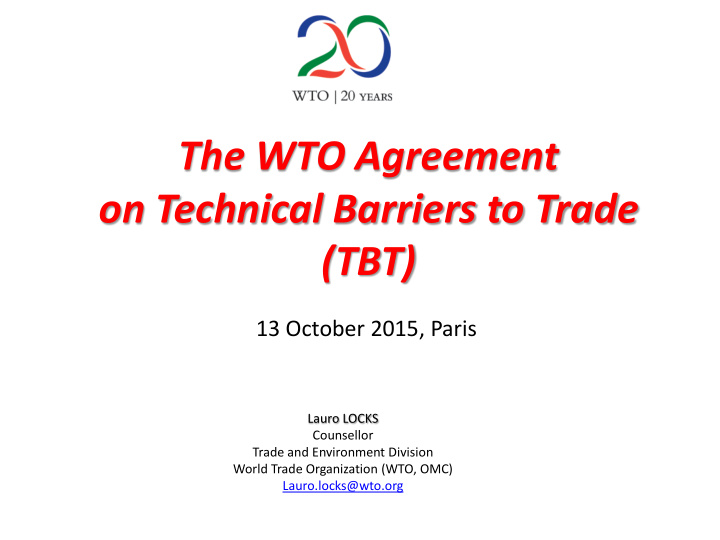



The WTO Agreement on Technical Barriers to Trade (TBT) 13 October 2015, Paris Lauro LOCKS Counsellor Trade and Environment Division World Trade Organization (WTO, OMC) Lauro.locks@wto.org
2
TBT Agreement Pursuit of trade liberalization… Right of Members’ to regulate… allowing Members to avoiding pursue legitimate unnecessary/discriminatory objectives at levels barriers to int’l trade they consider appropriate use of international standards …Harmonization …as a basis for regulation
Scope of the TBT Agreement TBT Measures… Technical Regulations Standards Conformity Assessment Procedures …related to all products (industrial and agricultural) (Art. 1.3)
Measures Voluntar Mandatory y Technical Standards Regulations Conformity Assessment Procedures Market
Conformity Assessment Procedures (CAP) “Any procedure used, directly or indirectly, to determine that relevant requirements in technical regulations or standards are fulfilled. Conformity assessment procedures include, inter alia, procedures for sampling, testing and inspection; evaluation, verification and assurance of conformity; registration, accreditation and approval as well as their combinations.” (TBT, Annex 1.3)
TBT Agreement principles for CAP (mandatory, mandated by government bodies) • Non-discrimination – Access for (foreign) suppliers under conditions no less favourable than accorded to suppliers of like products in a comparable situation • Avoid unnecessary barriers to trade – CAP shall not be more strict than necessary to give importing Member adequate confidence of conformity
TBT Agreement’s “balance” with respect to CAP Right of Members to … Pursuit of trade liberalization by… impose procedures avoiding that the choice of that give confidence CAP creates that risks associated unnecessary/discriminatory with products, barriers to int’l trade processes and systems are addressed use of international standards … Regulatory …as a basis for regulation Convergence
TBT Agreement’s “balance” with respect to CAP • The choice and design of CAP should be calibrated to the relevant requirements laid down in technical regulations or standards, such that the nature of risks embodied in the products, processes or systems in question are effectively addressed. • Example of “calibration”: – products that pose only minor risks which could be effectively mitigated through first-party testing and supplier's declaration of conformity schemes . – products which pose sufficiently high risks of a specific nature that may necessitate inspection and certification of production facilities and processes .
Arrangements to facilitate CAP (encouraged in TBT Agreement) • International or regional systems for conformity assessment – “Members shall, wherever practicable, formulate and adopt international systems for conformity assessment” – Systems such as ILAC/IAF, IECEE CB are increasingly prominent in TBT Committee discussions • Recognition of foreign conformity assessment results – “verified compliance, for instance through accreditation , with relevant guides or recommendations issued by international standardizing bodies shall be taken into account as an indication of adequate technical competence”
TBT Agreement : use of international standards (mandatory) Members shall use… technical conformity regulations assessment (Art. 2.4) procedures (Art. 5.4) “relevant” international standards … as a basis for Presumption of not creating an unnecessary barrier to trade when ineffective or when requirements are in inappropriate for policy except ! accordance with “relevant” objectives international standards (e.g. fundamental climatic or (Art. 2.5) geographical factors, or technological problems)
Notification/Publication Timeline: TR and CAP 1. Measure drafting 2. Notice publication 3. Notification to other Members (Art. 2.9.2, 5.6.2) reasonable time 4. Provision of copies (Art. 2.9.3, 5.6.3) Min. 60 days 5. Discussion of the comments (Art. 2.9.4, 5.6.4) 6. End of comment period 7. Adoption of the measure Reasonable 8. ( Prompt ) Publication of the measure (Art. 2.11, 5.8) interval Min. 6 months 9. Entry into force of the measure Exceptions for urgent reasons… (Art. 2.10, 5.7)
Work of the TBT Committee
Functions of TBT Committee Multilateral review of Specific Trade Concerns • – Around 35% STCs about use/non-use of international standards – Concerns related to certain standards and systems related to CAP are raised: • Clarification or encouragement to use certain relevant CAP standards • Non-acceptance of test results generated under systems such as ILAC Furthering implementation of the TBT Agreement ( Triennial Reviews )… • decisions and recommendations – Decision on principles for the development of int’l Standards – Discussions/exchange of information on CAP – GRP Participation of observers: BIPM (2014 Nov 2014 Thematic Session) of • the TBTC
TBT Notifications: statistics ( ∼ 25,000 notif. since 1995)
STCs raised in the TBT Committee: statistics ( ∼ 460 STCs since 1995)
TBT Committee Decision on Principles for the Development of International Standards, Guides and Recommendations (November 2000, G/TBT/9) “ Six Principles ” • Transparency • Openness • Impartiality and consensus • Relevance and effectiveness • Coherence • Development dimension
TBT Committee CAP discussions Committee discussions on CAP covering 3 thematic areas ( 6 th Triennial Review ): • What factors influence the choice and design of CAP? • The importance of using international guides and recommendations for CAP. • How to best facilitate the acceptance of conformity assessment results? For more details see: Overview of the TBT Committee's Work on Conformity Assessment Procedures – Note by the Secretariat - JOB/TBT/69, Oct. 2013
Good Regulatory Practice (TBT Committee voluntary guidelines) (still not finalized) Establish the potential need for government intervention, and define problem Publish a notice of regulatory activity Confirm the need for intervention Assess (e.g. Identify alternatives through RIA) Assess alternatives (e.g. RIA) Notify regulations to WTO Consultation Transparency Provide opportunity for comments and Consultation Take comments into account Publish final regulation and assessment Conduct regulatory (e.g. RIA) monitoring and reviews Transition period prior to entry into force Provide relevant guidance for compliance Provide special and differential treatment and technical assistance
Thank you ! lauro.locks@wto.org The WTO Agreements Series: Technical Barriers to Trade EN: https://www.wto.org/english/res_e/publications_e/tbttotrade_e.pdf FR: https://www.wto.org/french/res_f/publications_f/tbttotrade_f.pdf ES: https://www.wto.org/spanish/res_s/publications_s/tbttotrade_s.pdf
Recommend
More recommend